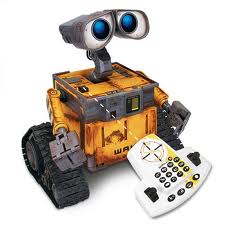Remote Control Robots
Remote Control Robots are in Your Future!

Remote Control Robots. A lot of people may think that a robot is not fully a robot if it isn’t autonomous, in other words if it is not able to move for extended periods of time without human intervention. The fact is that robot control systems have varying levels of autonomy, and tele-operated or remote control mode robot—where there is direct interaction between human and robot and the human has nearly complete control over the robot's motion—is one of them.
There is also the operator-assisted mode robot, where the human operator commands medium-to-high-level tasks, and the remote control robot automatically figures out how to achieve them. An autonomous robot, as stated, goes for long periods of time without human interaction, but doesn’t necessarily require more complex cognitive capabilities on the part of the robot. Assembly plant robots, for example, they not remote control robots, but are completely autonomous. They operate in a fixed and repetitive pattern.
While operator-assisted robots are widely used in space and military operations, remote control or RC robots find their popularity in homes, in the form of homemade models and toys. As it is, one of the most popular methods of robotic control is by either radio frequency or infra-red, which makes the robot operable by human hands from a distance. Every day, people are getting into robotics as a hobby, and though certainly a complicated task, RC robots are still perhaps the easiest one can build on his or her own.
In general, a remote control robot uses a micro-controller which act as the robot’s brain. It receives information from sensors and the input portion of the human interface(the remote control iteslef), decides what to do, then sends commands to the motion systems and the output part of the human interface. This is often done by writing a program and loading it into the micro-controller's memory.
Sensors provide the robot with data and information about its environment, such as sights, sounds, temperatures and other characteristics of its surroundings. Other parts of the remote control robots are their base (robot’s skeleton), motion systems (wheels, gears, motors and associated electronics that allow the robot move) and actuators (devices that can move things or control other devices). Some robots also have a human communications system, which allows them to” talk” via a computer generated voice, lights or text displays. It can also “listen” to instructions sent by keyboards, switches or wireless remote controls.
For those that would rather buy remote control robots than build them, there is a huge variety of RC robots on the market—mostly entertainment bots with some degree of camera or multimedia function. There are flying spy cameras like the Draganflyer X6, an RC mini helicopter especially made to carry wireless video cameras and still cameras that can capture images.
There’s a robot that rolls around on three wheels, tells jokes and gives its owners their daily fortune (aptly called Mr. Personality) and a multimedia robot called RS Media (RoboSapien Media) with a head-mounted camera, LCD screen, built-in microphone, speakers, and MP3 player. It can download and display internet information and can dance pretty well, too.
For the more traditional, there is still a wide variety of standard RC flying and moving vehicles, like the hovering space surfer, or mini hovercrafts which measure only 4” in length. These hovercrafts use infrared beams as controls, hence they need to be operated in line of sight. A growing number of robot kits are also available using infrared (IR) remote controls, like the Soccer Robot and the Space Nine, an eight-legged IR remote controlled robot that can walk on rough surfaces. Robots controlled through the internet have also become popular, like Spykee, a robotic toy made that contains a USB webcam, microphone and speakers.
This bot can be controlled locally by a computer or over the internet, and can move to different locations within the range of the local router. In doing so, Spykee can take pictures and video, listen to surroundings with the on-board microphone and play built-in or recorded sounds or music.
Similar to the Spykee is Rovio, a Wi-Fi enabled mobile spy cam that allows owners to view and interact with an environment through streaming video and audio, wherever there is an internet connection. It is exciting to note that these robots can be remotely controlled from ANYWHERE in the world transmitting real-time images, giving the user instant and relatively cheap telepresence, in other words, giving the person controlling the robot the feeling that they are actually present in the location where the robot is.
Now that robotic toys easily double as entertainment systems and security cameras for the household, it seems there’s no telling what they could do in just a couple more years. I can’t wait for someone to invent an RC robotic butler. Just think, you could hire someone thousands of miles away to use a RC butler to pour your afternoon tea.
“Tea James. One lump of sugar and a bit of cream please.”
“Yes, sir. Right away.”